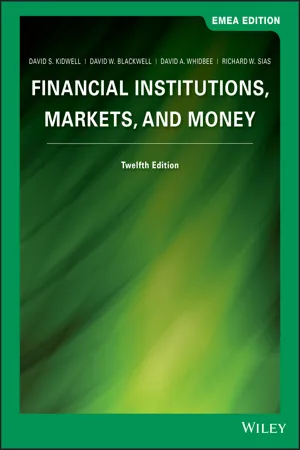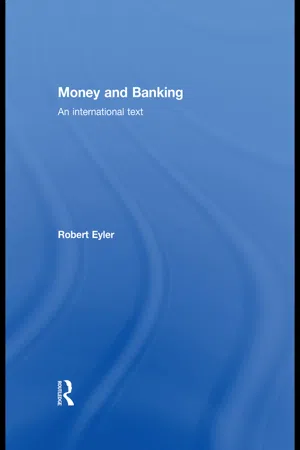Economics
Short Run Interest Rate
The short run interest rate refers to the interest rate on loans and financial instruments that is applicable over a relatively brief period, typically up to a year. It is influenced by factors such as central bank policies, inflation expectations, and market demand for credit. Changes in the short run interest rate can impact borrowing costs, investment decisions, and overall economic activity.
Written by Perlego with AI-assistance
Related key terms
1 of 5
3 Key excerpts on "Short Run Interest Rate"
- eBook - PDF
Financial Institutions
Markets and Money
- David S. Kidwell, David W. Blackwell, David A. Whidbee, Richard W. Sias(Authors)
- 2020(Publication Date)
- Wiley(Publisher)
This chapter explains the role of interest rates in the economy and provides a basic explanation of the fundamental determi- nants of interest rates. The chapter serves as a foundation for Chapters 5 and 6, which also deal with interest rates. ■ vectorfusionart/Shutterstock Even though we understand the factors that cause interest rates to change, only people who have a crystal ball can predict interest movements well enough to make consistent profits. The gutters of Wall Street are littered with failed interest rate prediction models. 4.1 WHAT ARE INTEREST RATES? For thousands of years, people have been lending goods to other people, and on occasion, they have asked for some compensation for this service. This compensation is called rent— the price of borrowing another person’s property. Similarly, money is often loaned, or rented, for its purchasing power. The rental price of money is called the interest rate and is usually expressed as an annual percentage of the amount of money borrowed. Thus, an interest rate is the price of borrowing money for the use of its purchasing power. To a person borrowing money, interest is the penalty paid for consuming income before it is earned. To a lender, interest is the reward for postponing current consumption until the maturity of the loan. During the life of a loan contract, borrowers typically make periodic interest payments to the lender. On maturity of the loan, the borrower repays the same amount of money borrowed (the principal) to the lender. Like other prices, interest rates serve an allocative function in our economy. They allocate funds between surplus spending units (SSUs) and deficit spending units (DSUs) and among financial markets. For SSUs, the higher the rate of interest, the greater the reward for postponing current consumption and the greater the amount of saving in the economy. - eBook - ePub
Money and Banking
An International Text
- Robert Eyler(Author)
- 2009(Publication Date)
- Routledge(Publisher)
Something we will explore in depth when we talk about money demand later is the idea of the interest rate as the opportunity cost of having cash in your pocket. This relationship between the quantity of cash or liquidity demanded and the interest rate is of key importance to a great deal of macroeconomic theories but also to monetary and fiscal policy in practice. The way consumers react to changes in interest rates paid on their cash holdings changes the demand for goods and services, as well as the demand for lending. However, for now the idea is simple: the interest rate is the opportunity cost of holding money in your wallet rather than in an interest-bearing account or investment.Measure of time preference
It is this definition that links the three above and binds them in the household’s eyes. When you chose to consume more than your income, or consume with credit rather than paying in full, you are making a choice about your time preference to consume. The interest rate is a measure of how people prefer to consume with respect to time: if the interest rate falls, there will be marginal changes in consumption based on a smaller cost of credit. Certain households which initially would save, say $1000, now spend $100 of that $1000 and save only $900. They still save a certain amount, but it is less. The lower interest rate has triggered an incentive for them to spend on credit, or prefer to spend now than later in time.The cost of borrowing falls in the previous example, providing an incentive to borrow. Certain lenders must provide the loan, thus they see the interest rate as the revenue from lending, and want to take advantage of it. Finally, the borrower must demand cash in order to spend, thus the cost of holding money must also be going down at the same time, and intuitively it does. The interest rate is all four of these ideas simultaneously, and must be for financial markets to work correctly. We will see later that the interest rate’s measure of time preference characteristic makes the entire economy work correctly. - eBook - PDF
- Scott Besley, Eugene Brigham, Scott Besley(Authors)
- 2021(Publication Date)
- Cengage Learning EMEA(Publisher)
Thus, although investing short-term generally preserves one’s principal, the interest income provided by short-term investments varies from year to year, depending on reinvestment rates. The im- plications of interest rate risk and reinvestment rate risk are discussed in greater detail in Chapter 6. 5-3 THE TERM STRUCTURE OF INTEREST RATES A study of Figure 5.2 reveals that at certain times, such as in 2002– 2004 and 2008–2016, short-term interest rates are substantially lower than long-term rates. At other times, such as in 2006–2007, short-term rates nearly equal, and in some instances ac- tually exceed, long-term rates. The relationship between long-term and short-term rates, which is known as the term structure of interest rates, is important to corpo- rate treasurers, who must decide whether to borrow by issuing long-term or short-term debt, and to investors, who must decide whether to buy long-term or short-term bonds. For these reasons, it is important to understand (1) how long-term and short-term rates are related, and (2) what causes shifts in their relative positions. The relationship between long-term and short-term bonds varies and generally is dependent on the supply- and-demand relationship that exists for these bonds at a particular point in time (generally on a specific date). For example, the tabular section of Figure 5.4 includes interest rates for different maturities on three differ- ent dates. The set of data for a given date, when plot- ted on a graph such as that in Figure 5.4, is called the term structure of interest rates The relationship between yields and maturities of securities. FIGURE 5.4 U.S. TREASURY BONDS: INTEREST RATES ON DIFFERENT DATES (YIELD CURVES) Years to Maturity Long Term Intermediate Term Short Term Interest Rate (%) 4 3 2 5 6 0 1 January 2007 January 2017 November 2006 5 10 15 20 1 Source: Federal Reserve, https://www.federalreserve.gov.
Index pages curate the most relevant extracts from our library of academic textbooks. They’ve been created using an in-house natural language model (NLM), each adding context and meaning to key research topics.


